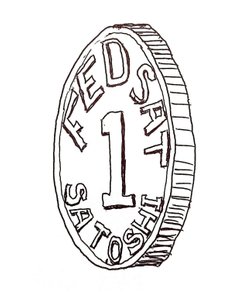This is a silly little thought exercise that will never happen.
The U.S. dollar used to be backed by gold, at least in theory if not in practicality. The theory was that you could swap your paper USD notes for gold...an easy enough concept that helps build trust in money. Well, that so-called "gold standard" ended in 1971.
I just read an article that the U.S. government holds more BTC than MicroStrategy and Tesla combined, making the USA the largest known BTC hodler. The estimate in the article is that the U.S. controls 205,000 BTC worth $5.7 billion.
What if the U.S. dollar was backed by Bitcoin?
Plan A
$5.7 billion worth of BTC is not nearly enough to back USD notes. So, let's expand things up and flesh them out.There are 100 million satoshis in one bitcoin. So, 205,000 BTC times 100,000,000 means the U.S. has this many sats: 20,500,000,000,000. That's 20.5 trillion sats (if I did my math right and got all the zeroes in the right spot!).
Right now the M2 money supply is about $21,000 billion (in another way, it's 21 trillion dollars). Recall that M2 is liquid money and savings. There are lots of other "dollars" out there too: your stock portfolio, your house, land, property that you own. For many, those things likely are the bulk of one's wealth. However, since we're talking money and dollars and the general liquidity that money provides, let's go with M2.
What if each dollar in the M2 bucket was backed by one sat?
By "backed" I mean that they could be swapped back-and-forth at will. If you wanted to exchange your dollars and receive Bitcoin sats, you could. If you wanted to exchange your sats and receive dollars you could.
If the exchange was set at $1:1sat, we'd have $21T dollars backed by 21T sats. Well, we only have 20.5T sats in the U.S. government's bags, we'll have to scrounge up the other 0.5T sats to get to the $21T:21T sats balance. But, hey, let's just go with it for now.
You might say, "The value of one sat isn't anywhere close to one dollar. No way I'm swapping a dollar for a sat." You'd be correct. In fact, one satoshi isn't even remotely close to one penny, currently. (You can check the current rate by typing .01 into this tool. And, oh, the penny-to-sat ratio isn't as crazy as you might think. One U.S. penny right now buys you 34 sats, not 10,000 or a million. And, the higher the BTC price goes, the fewer sats you get. When I first made that tool, your penny then got you 110 sats.). So, why would anyone wish to exchange a dollar for a sat? Two thoughts, (1) right now, they wouldn't, but in the future...who knows? And (2), because backed-by-something is better than backed-by-nothing.
Something is better than nothing
But, what if the point wasn't so much the exchange rate value, but the intrinsic swapability of the dollar and the satoshi? What if the point is that being backed by something is better than being backed by nothing?

To stretch this out further, suppose each satoshi was subdivided into a satoshi derivative. How this would work, I'm not entirely sure. However, there are very clever people in tech/crypto/finance and I have little doubt that a such a thing could be cooked up. Perhaps a layer 2 sidechain derivative token could be created. Call it the FEDSAT chain. Each of the 184T sats could have an alternate sat on FEDSAT. And, each FEDSAT satoshi could be divided into decimals, let's say 8 the way that BTC is delineated into 8 decimals. Now, we're talking big numbers of FEDSAT sats and real divisibility.
The current value imbalance issue of dollar-to-satoshi would certainly be there and be real. But, the point is that the currently infinite supply of the dollar could conceivably be backed by the hard-money, finite supply of Bitcoin. Although new dollars could and would always be minted, the supply of FEDSAT sats would be finite and solid. As long as the guarantee of an exchange between the two was kept with fidelity, those finite FEDSAT sats would grow in value in relation to the dollar. In the inverse view, it would continually cost more in USD to get the same amount of FEDSAT sats.
The other point of doing this...at least the dollar would be backed by something, instead of today where it is backed by nothing.
Plan B
If Plan A is too out there, with its layer 2 and every dollar having a satoshi and decimal sats linked to those dollars, there's Plan B.
With Plan B, the 205,000 BTC could be used to back its current dollar value, which again, is $5.7 billion. We figured earlier in this post that each penny is currently worth 34 sats. Suppose you could swap your USD pennies for sats at any time in either direction. This bi-directional swapping service would play out at the current USD-BTC open market exchange rate.
What we'd essentially have here is less of a dollar-backed-by-bitcoin than simply a swapping service. Here's the way I think this would play in going forward...
The U.S. dollar's supply is infinite and more will continually be minted. Its supply will continually increase. The 205,000 BTC in the swapping pool is finite and will never increase. Since the pool of USD enlarges, its relative value declines in comparison to the finite BTC in the pool. More dollars are chasing the same number of sats. As time progresses and someone wished to exchange for those 34 sats, they'd need more USD because the USD simply isn't worth what it once was. In another way, that one penny will now get you only 33 sats, then 32, or only 31, and then...
Scary part of it
Bitcoin ordinals have recently shown us how a satoshi, one particular satoshi, can be purposely transferred. With ordinals, each satoshi is numbered and therefore is special. This individuality, combined with the ability to inscribe or write data associated with each satoshi, is what makes ordinals as NFTs. It puts the "U" into what I defined as "verified unique ownership." (That post was a predecessor of my wondering that Hive posts might actually be NFTs themselves. Hmm.)
It's probably not advisable to tag dollars to specific sats because the purpose of money is fungibility, not nonfungibility. The frightening part of this is that doing such a thing as this would effectively create a CBDC (central bank digital currency). I'll admit, I like the idea of a CBDC, at least in principle in that is seems so much more practical now to deal with money digitally rather than in paper and metal. The scary part of a CBDC is the tracking, though. Despite what people may think, Bitcoin transactions are not 100% anonymous. Every tx is logged on chain forever. Tracing coins and connection wallets and transactions drops hints and breadcrumbs. And with each satoshi possibly being identified as unique, every single sat could be tracked. The privacy and surveillance possibilities are numbing and creepy. As a result, I've certainly curbed my enthusiasm on CBDCs.
Wrap up
This is kind of an odd imagining out loud. It's likely not even feasible...the economics likely aren't practical...you can never get around numbers. Still, it's interesting to consider.
And, it'll never happen. With Plan A, I'm sure that if the U.S. ever goes full CBDC they will create a FEDDOLLAR type of token. And I'm sure the money supply will be limitless. The print-and-spend drug is too strong. With Plan B, I'm also sure that the U.S. government doesn't want to run a dollar/bitcoin swapping service. Just thinking out loud.

Not on Hive yet? Watch the animation I made: The Hive Story Animation and you'll learn all about it. The top benefits of the Hive blockchain: (1) no ONE person/group runs it, (2) YOU own and control your content, and (3) YOU earn the rewards that your content generates. Learn more or consider using my referral link to get your free account here and I'll support you as you begin. Alternately, you can see other sign-up options here.